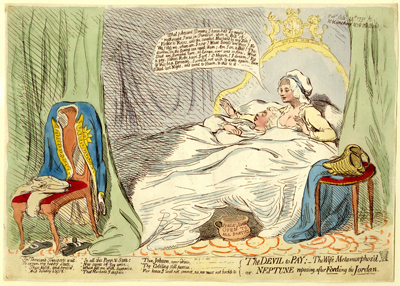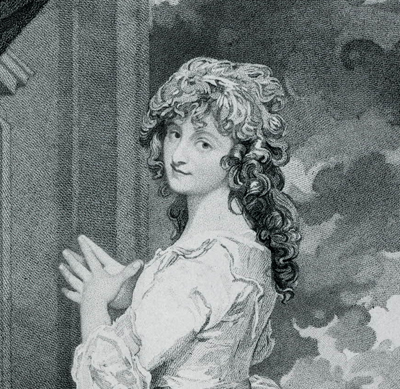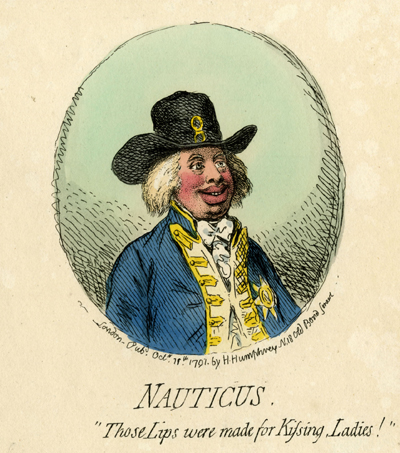The Devil to Pay. . .
In this print Gillray shows the celebrated actress, Mrs. Dorothea Jordan, delighted to find herself in bed with Prince William, Duke of Clarence. She is identified by the chamber pot in the foreground, also known as a "jordan." He is identified by the royal bedstead and naval uniform draped over the chair.

© Trustees of the British Museum
The scarcely caricatured portrait of Mrs. Jordan may have been taken from life. Gillray was an avid theatre-goer and would have had the opportunity to see her in the month preceding this print as both Lydia Languish in Sheridan's The Rivals, and Rosalind in As You like It. But he may also have seen the print of Mrs. Jordan published in 1788 based upon the painting by George Romney. There is indeed some resemblance.

Mrs. Jordan [1788]
© Trustees of the British Museum
The Duke of Clarence is more of a caricature, portrayed as the full-lipped lover boy Gillray had created two weeks earlier in the print, Nauticus whose subtitle was ("Those Lips were made for Kissing, Ladies.") The naval uniform is the same in both prints.

© Trustees of the British Museum
The full title of this etching is The Devil to Pay. The Wife Metamorphos'd, or Neptune Reposing after Fording the Jordan. The first part of the title alludes to the popular ballad farce, The Devil to Pay, or The Wives Metamorphos'd (1731) written by Charles Coffey and recently revived (October 19th) at the King's Theatre, Hay-Market with Mrs. Jordan in the role of Nell Jobson.
In that piece Nell, the good-hearted and long-suffering spouse of a wife-beating cobbler, is temporarily metamorphosed into the wealthy and pampered Lady Loverule. The speech bubble and verses beneath Gillray's print are taken directly from the play and express Nell's (and now Mrs. Jordan's) satisfaction at the elevation of her status.
Dorothea Jordan (nee Bland) was one of six natural children of an actress mother and an Irish stagehand father who abandoned the family when Dorothea was thirteen. It's not surprising with her family strapped for cash, Dora, as she was then known, would find her way to the stage to supplement the family income. So at sixteen, she began to play minor roles, such as Phoebe in As You Like It in Irish theaters, graduating to larger roles and English theaters over the course of eight years. By then, calling herself Mrs. Jordan, she is said to have made her London debut in 1785 as Miss Peggy, in David Garrick's The Country Girl.
Along the way, the witty and attractive Mrs. Jordan became the mistress of at least five men most of whom were associated with the acting profession. That explains (but does not justify) the typically chauvinistic label on the chamber pot: "Public Jordan Open to All Parties."
The most recent of Mrs. Jordan's lovers was Sir Richard Ford, a magistrate and lawyer who had promised to marry her. But after five years, three illegitimate children, and no marriage in sight, Mrs. Jordan decided to take her chance with the Duke of Clarence. The newspapers in mid October 1791 were full of reports about her split from Ford, the infatuation of the Duke of Clarence, and even the terms of the settlement Mrs. Jordan's lawyers were negotiating in transferring her affections from Ford to the young Prince.
The press had a field day with the numerous puns offered by the names of the parties involved and the profession of the Prince. In the Evening Mail for October 14th, for instance, there was this:
That the Jordan has crossed the Ford, is a matter no longer to be doubted, and the Royal Admiral has hoisted his flag—how long the vessel will be in commission is become a matter of conversation. . . .
So Gillray had plenty of precedent for the rest of his title: "Neptune Reposing after Fording the Jordan"
By now Gillray must have known that prints of royals in bed were good for sales. He had already commemorated George, the Prince of Wales in The Morning After Marriage, or A Scene on the Continent (1786) and Frederick, Duke of York in The Accomodating Spouse; (1789), so it was fitting that the King's third son, William, Duke of Clarence should now be given equal recognition.
Sources and Reading
- Commentary from the British Museum on The Devil to Pay. . .
- The Devil to Pay Or, The Wives Metamorphosed: A Ballad Farce
- "Dorothea Jordan," Wikipedia
- "William IV of the United Kingdom," Wikipedia
Comments & Corrections
NOTE: Comments and/or corrections are always appreciated. To make that easier, I have included a form below that you can use. I promise never to share any of the info provided without your express permission.